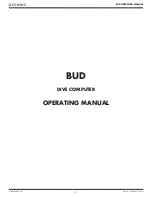
Appendix B: Automatic Measurements Reference
B- 18
CSA8000B & TDS8000B User Manual
Table B- 4: RZ Measurements - Amplitude (cont.)
Name
Definition
RZ Extinction Ratio (dB)
The ratio of the average power levels of the logic 1 level (High) to the logic 0 level (Low) of an
optical RZ signal, expressed in decibels, dB. All level determinations are made within the RZ
Eye Aperture.
Where High and Low are the logical 1 and 0 levels. See
RZ Eye Aperture Parameters
on B--62.
The Eye Aperture is adjustable and defaults to 5% of the RZ pulse width.
If enabled, measurement gates constrain the measurement region to the area between the Start
Gate (G1) and Stop Gate (G2). See
To Localize a Measurement
on page 3--83.
This measurement requires the use of a waveform database. When this measurement is turned
on, it will automatically set the measurement system to use a waveform database if available.
See
Use a Waveform Database
on page B--70.
For best measurement results:
H
Always perform a Dark Level compensation before taking this measurement. See
To
Perform Dark-Level and User Wavelength Gain Compensations
on page 3--98.
H
Optimize the vertical resolution before taking this measurement. See
To Optimize the
Vertical Resolution
on page B--69.
RZ ExtRatio
[
dB
]
=
10
×
log
Ꮛ
High
Low
Ꮠ
RZ Eye Height
RZ Eye Height is a measure of how noise affects the vertical opening between the High and
Low levels of an RZ pulse. The RZ pulse is sampled within the Eye Aperture, where the High
and Low levels are determined as the mean of the histogram of the data distribution in the
upper and lower half of the pulse, respectively. The noise levels are characterized by
σ
high and
σ
low, the standard deviations from the mean for the High and Low levels.
RZ Eye height = (High – 3 *
σ
high) – (Low + 3 *
σ
low),
Where High and Low are the logical 1 and 0 levels, and
σ
high and
σ
low are the standard
deviations.
The Eye Aperture is adjustable and defaults to 5% of the RZ pulse width.
If enabled, measurement gates constrain the measurement region to the area between the Start
Gate (G1) and Stop Gate (G2).
This measurement requires the use of a waveform database. When this measurement is turned
on, it will automatically set the measurement system to use a waveform database if available.
For best results with this measurement:
H
Perform a Dark Level compensation before taking this measurement if the source of the
measured waveform is an optical channel. See
To Perform Dark-Level and User
Wavelength Gain Compensations
on page 3--98.
H
Optimize the vertical resolution before taking this measurement. See
To Optimize the
Vertical Resolution
on page B--69.
Summary of Contents for CSA8000B Series
Page 4: ......
Page 18: ...Preface xiv CSA8000B TDS8000B User Manual ...
Page 26: ...Check the Package Contents 1 8 CSA8000B TDS8000B User Manual ...
Page 62: ...Accessories and Options 1 44 CSA8000B TDS8000B User Manual ...
Page 76: ...Overview 3 2 CSA8000B TDS8000B User Manual ...
Page 112: ...Acquiring Waveforms 3 38 CSA8000B TDS8000B User Manual ...
Page 126: ...Triggering 3 52 CSA8000B TDS8000B User Manual ...
Page 146: ...Displaying Waveforms 3 72 CSA8000B TDS8000B User Manual ...
Page 174: ...Measuring Waveforms 3 100 CSA8000B TDS8000B User Manual ...
Page 186: ...Creating Math Waveforms 3 112 CSA8000B TDS8000B User Manual ...
Page 214: ...Data Input and Output 3 140 CSA8000B TDS8000B User Manual ...
Page 353: ......
Page 354: ......
















































